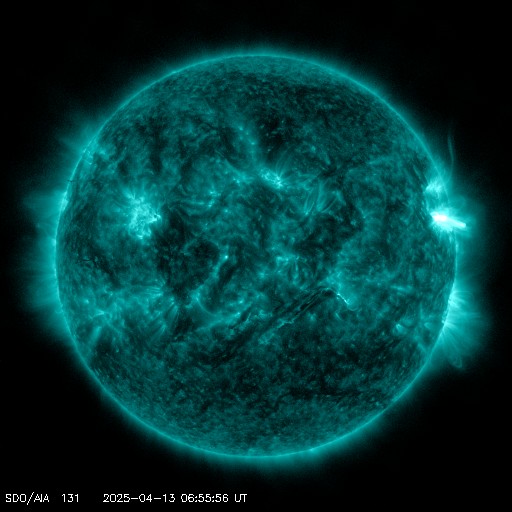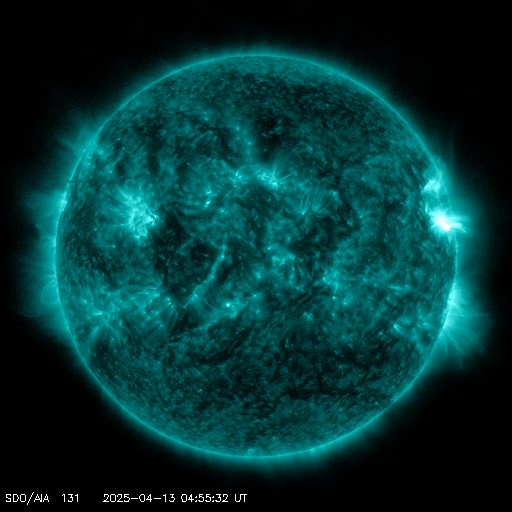Het archief bekijken van zondag 28 juli 2024
Dagelijks bulletin over zonne- en geomagnetische activiteit van het SIDC
Datum verslag: 2024 Jul 28 1246 UTC
SIDC Prognose
Zonnevlammen
M-class flares expected (probability >=50%)
Geomagnetisme
Quiet (A<20 and K<4)
Proton Flux monitor
Quiet
| 10cm flux | Ap | |
|---|---|---|
| 28 Jul 2024 | 205 | 008 |
| 29 Jul 2024 | 206 | 008 |
| 30 Jul 2024 | 205 | 009 |
Zonnevlekkengebieden en zonnevlammen
The solar flaring activity was at high level during the last 24 hours, with few C-class flares and seven M-class flares. The strongest flare was GOES M9.9 flare from NOAA active region (AR) 3766 which peaked at 01:57 UTC on Jul 28. During the flare, the source region (AR 3766) of the flare had beta configuration of its photospheric magnetic field. NOAA AR 3766 produced three M-class flares and NOAA AR 3762, which is the most complex region on the disk (beta-gamma-delta magnetic field configuration), produced four M-class flares. The solar flaring activity is expected to be at moderate to high levels over the next 24 hours, possibly with few M-class flares and a chance for isolated X-class flares from NOAA AR 3766 or NOAA AR 3762.
Coronale massa uitstoten
Further analysis of the partial halo coronal mass ejection (CME), which was first observed in the SOHO/LASCO-C2 images around 05:00 UTC on Jul 27, has shown that this CME was possibly a backsided event. A halo CME was first observed in the SOHO/LASCO C2 images around 06:30 UTC on Jul 27. This CME was possibly associated with a M3.1 flare, which peaked at 05:46 UTC on Jul 27, produced by NOAA AR 3762 (S11 W25). Possibly associted type IV radio emissions were detected at 06:43 UTC on Jul 27. With a projected speed of about 450 km/s, it is expected to impact the Earth on 30-31 Jul. Another halo CME was first observed in the C2 images around 02:24 UTC on Jul 28. It was associated to the two subsequent M-class flares from the NOAA AR 3766 (S07 E10) and the EUV wave. The first M7.8 flare peaked at 01:51 UTC and the second M9.9 flare peaked at 01:57 UTC on Jul 28. Associated type II radio emissions were detected at 01:51 UTC on Jul 28, during the flaring activities. With a projected speed of about 470 km/s and its source region located closer to the central meridian, it is expected to impact the Earth later on the evening of July 31. A narrow CME, with an angular width of about 60 deg, first appeared in the C2 field of view around 05:50 UTC on Jul28. This CME was associated to a prominence eruption in the NE quadrant of the Sun. With the bulk of the mass going strongly NE, it is not expected to arrive at Earth. No other Earth-directed CMEs were detected in the available coronagraph observations during the last 24 hour.
Zonnewind
Earth is presently within the slow solar wind regime. The solar wind speed ranged between 375 km/s and 435 km/s. The North-South component (Bz) ranged between -5 and 5 nT. The interplanetary magnetic field ranged between 3 nT and 8 nT. Slow solar wind conditions are expected to continue over the next 24 hours.
Geomagnetisme
Geomagnetic conditions were globally and locally at quiet to active conditions (NOAA Kp and K BEL 1 to 4). Quiet to unsettled conditions are expected in the next 24 hours.
Proton flux niveaus
The greater than 10 MeV GOES proton flux was below the threshold level over the past 24 hours. It is expected to remain so during the next 24 hours.
Elektronenfluxen in geostationaire baan
The greater than 2 MeV electron flux, as measured by the GOES-16 satellite, was below the threshold level over the past 24 hours and is expected to remain so in the coming 24 hours. The 24h electron fluence is presently at normal level, and it is expected to remain so in the next 24 hours.
Het geschatte internationale zonnevlekkengetal (ISN) van vandaag: 197, gebaseerd op 20 stations.Zon indexen voor 27 Jul 2024
| Wolfgetal Catania | /// |
| 10cm zonneflux | 204 |
| AK Chambon La Forêt | 015 |
| AK Wingst | 019 |
| Geschatte Ap | 013 |
| Geschat internationaal zonnevlekkengetal | 210 - Gebaseerd op 21 stations |
Overzicht opvallende gebeurtenissen
| Dag | Start | Max | Einde | Locatie | Sterkte | OP | 10cm | Catania/NOAA | Soorten radio-uitbarstingen |
|---|---|---|---|---|---|---|---|---|---|
| 27 | 1750 | 1806 | 1817 | S05E17 | M2.7 | 2B | 33/3765 | III/2 | |
| 27 | 1824 | 1839 | 1851 | S09W30 | M3.4 | 1B | 26/3762 | VI/2 | |
| 28 | 0139 | 0151 | 0153 | ---- | M7.8 | 32/3766 | |||
| 28 | 0153 | 0157 | 0201 | ---- | M9.9 | 32/3766 | |||
| 28 | 0337 | 0348 | 0403 | S10W37 | M1.5 | SF | 26/3762 | ||
| 28 | 1027 | 1042 | 1054 | S10W39 | M7.7 | SF | 26/3762 |
Aangeboden door het Solar Influences Data Analysis Center© - SIDC - Verwerkt door SpaceWeatherLive
Alle tijden in UTC
<< Keer terug naar de dagelijkse overview pagina
Laatste nieuws
Laatste forumberichten
Steun Poollicht.be!
Om ook bereikbaar te blijven bij grote poollichtkansen hebben we een zware server nodig die alle bezoekers aankan. Doneer en steun dit project zodat we online blijven en je geen enkele poollichtkans mist!

Laatste alerts
07:12 UTC - Zonnevlam
Matige M1.02 zonnevlam
06:54 UTC - Radio blackout
Kleine R1 radio blackout gedetecteerd (≥M1 - momenteel: M1.02)
05:12 UTC - Zonnevlam
Matige M2.31 zonnevlam
04:54 UTC - Radio blackout
Kleine R1 radio blackout gedetecteerd (≥M1 - momenteel: M1.89)
04:48 UTC - Zonnevlam
Matige M1.12 zonnevlam
Ruimteweer feitjes
| Laatste X-klasse uitbarsting | 28/03/2025 | X1.1 |
| Laatste M-klasse uitbarsting | 13/04/2025 | M2.2 |
| Laatste geomagnetische storm | 06/04/2025 | Kp5 (G1) |
| Zonnevlekkenloze dagen | |
|---|---|
| Laatste zonnevlekkenloze dag | 08/06/2022 |
| Maandelijks gemiddeld zonnevlekkengetal | |
|---|---|
| maart 2025 | 134.2 -20.4 |
| april 2025 | 136.4 +2.2 |
| Afgelopen 30 dagen | 134.7 -7.2 |





